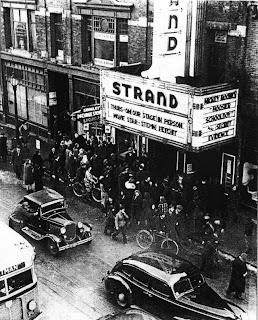On this day in 1914, the first “Movie Palace” opens to the public in New York City.
The Mark Strand Theatre located at Broadway and 47th Street, in the heart of Manhattan’s Theater District, was the creation of Mitchell L. Mark, who began his motion-picture career as a producer but later became an exhibitor. Before 1914, motion-picture exhibitors had generally showcased their offerings behind modest storefronts, dubbed “nickelodeons” after the original Nickelodeon that opened in Pittsburgh in 1905. By contrast, the Mark Strand Theatre--later known simply as the Strand--was the first of the so-called “dream palaces,” called as such for their impressive size and luxuriously appointed interiors. The Strand seated around 3,000 people and boasted a second-floor viewing balcony and (in an architectural innovation at the time) a two-story rotunda where moviegoers could socialize before and after the presentation and during intermission.
On the night before it debuted to the public, the Mark Strand Theatre held its opening-night gala, which the next day’s newspapers called “a sensation” (according to a 1938 retrospective on the Strand published in the New York Times) In addition to the feature presentation that night--The Spoilers, a drama starring William Farnum--the audience was treated to a performance by the Strand’s concert orchestra; The Neapolitan Incident, which the program called “a collaboration of the motion picture and song”; songs by the Strand Quartet; and a Keystone comedy short. By 1916, the number of movie palaces in the United States had topped 21,000. Instead of a program of short films, these theaters would show a full-length feature presentation in order to charge patrons premium prices. The movie-palace boom (and the corresponding demise of the nickelodeons) marked the beginning of the rise of the studio system.



No comments:
Post a Comment